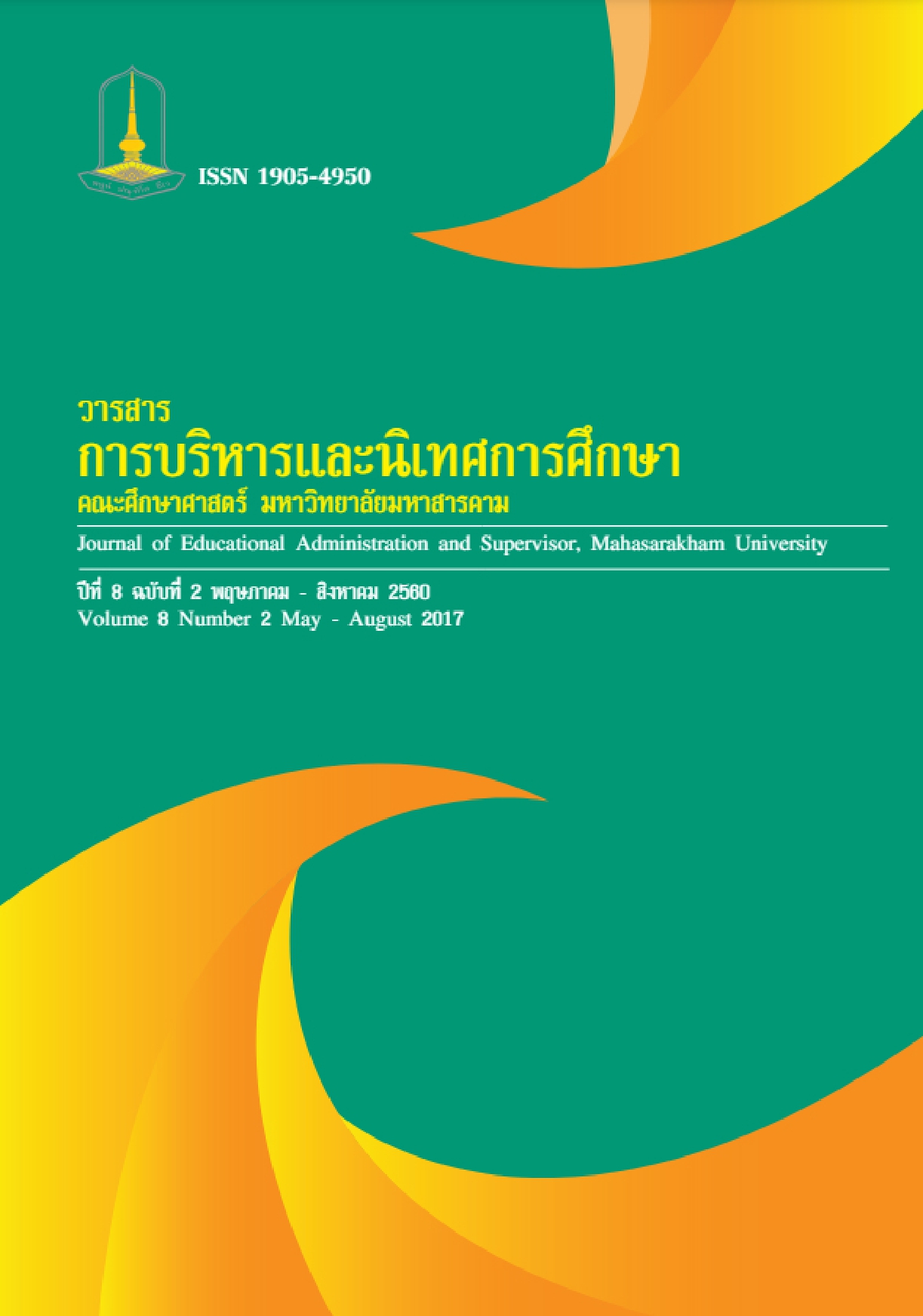Development of Academic Administration Guidelines for the Educational Institutions under Surin Office of Primary Education Service Area 3
Main Article Content
Abstract
The research aimed to 1) study the components and indicators of academic administration of the educational institutions ; 2) study the current state and the desirable state of academic administration of the educational institutions ; and 3) develop academic administration guidelines for the educational institutions under Surin Office of Primary Education Service Area 3. The study was divided into 3 phases. Phase 1 dealt with the study of the components and indicators of academic administration of the educational institutions. The informants were 5 certified scholars in suitability assessment. Phase 2 dealt with the study of the current state and the desirable state of academic administration of the educational institutions under Surin Office of Primary Education Service Area 3. The sample consisted of 105 persons obtained through stratified random sampling. And Phase 3 was the development of academic administration guidelines for the educational institutions under Surin Office of Primary Education Service Area 3. The informants interviewed were 9 certified scholars holding an academic position. They were educational institution directors and chiefs of academic affairs. The instruments comprised a questionnaire with the discrimination ranging from 0.26 to 0.74 and the total reliability of 0.81, an interview form, and a suitability and feasibility assessment form. The analysis employed the mean and standard deviation.
The results are as follows: 1. The study of the components and indicators of academic administration of the educational institutions under Surin Office of Primary Education Service Area 3 revealed 7 components: 1) school-based curriculum development, with 4 indicators ; 2) learning process development, with 4 indicators ; 3) measurement and evaluation, with 2 indicators ; 4) research for educational quality development, with 3 indicators ; 5) educational supervision, with 3 indicators ; 6) educational guidance, with 3 indicators ; and 7) internal quality assurance system development, with 3 indicators. 2. The study of the current state and the desirable state of academic administration revealed that the current state, on the whole and by aspect, was in the high level, and the desirable state of academic administration, on the whole and by aspect, was in the high level. 3. Regarding the academic administration guidelines for the educational institutions under Surin Office of Primary Education Service Area 3 basing on the need analysis (PNImodified), the top 3 aspects were: educational supervision, educational guidance, and internal quality assurance system development, respectively. The academic administration guidelines of the educational institutions were: the results of supervision should be used in planning seriously ; the educational institution should organize the academic guidance system through meetings, exchanging ideas, making suggestions, and making a work calendar ; the organizational structure should be organized to support the internal quality assurance system of the educational institution ; the core curriculum should be studied clearly ; every party should take part in curriculum development and implementation as well as in teacher mentor system development to assist teachers in conducting their research by inviting experts to impart research knowledge to the teachers ; the administrator should set regulations for measurement and evaluation and monitoring ; the teachers should develop themselves in effective and learner-centered instructional organization techniques through seminars, media, documents and videos.
The academic administration guidelines for the educational institutions under Surin Office of Primary Education Service Area 3, as assessed by the certified scholars, revealed the suitability in the high level and the feasibility was in the high level.
Downloads
Article Details
References
กระทรวงศึกษาธิการ. (2546). การบริหารสถานศึกษาที่เป็นนิติบุคคล. กรุงเทพฯ: กระทรวงศึกษาธิการ.
ชัชฏาภรณ์ ไชยฤทธิ์. (2554). ปัญหาและแนวทางในการพัฒนาการบริหารงานวิชาการของโรงเรียนขนาดเล็ก ในเขตอำเภอแกลง สังกัดสำ นักงานเขตพื้นที่การศึกษาระยอง เขต 2. วิทยานิพนธ์ กศ.ม. ชลบุรี: มหาวิทยาลัยบูรพา.
ชุมศักดิ์ อินทรรักษ์. (2551). การบริหารงานวิชาการ. ปัตตานี: ภาควิชาการบริหารการศึกษา คณะศึกษาศาสตร์.
นิตยา พูลแสง. (2554). ปัญหาและแนวทางการพัฒนาการบริหารงานวิชาการโรงเรียนประถมศึกษา สังกัดสำนักงานเขตพื้นที่การศึกษาประถมศึกษาสระแก้ว เขต 2. วิทยานิพนธ์ กศ.ม. ชลบุรี: มหาวิทยาลัยบูรพา.
บุญเพ็ง กุละนาม. (2550). รูปแบบการบริหารงานวิชาการโรงเรียนจัดการศึกษาภาคบังคับสังกัดสำนักงานเขตพื้นที่การศึกษาสกลนคร เขต 2. วิทยานิพนธ์ ค.ม. สกลนคร: มหาวิทยาลัยราชภัฏสกลนคร.
ปรียาพร วงศ์อนุตรโรจน์. (2546). การบริหารงานวิชาการ. กรุงเทพฯ: ศูนย์สื่อเสริมกรุงเทพฯ.
ปรียาพร วงศ์อนุตรโรจน์. (2553). การบริหารงานวิชาการ. กรุงเทพฯ: ศูนย์สื่อเสริมกรุงเทพฯ.
รุ่งชัชดาพร เวหชาติ. (2550). การบริหารงานวิชาการ สถานศึกษาขั้นพื้นฐาน. สงขลา: ภาควิชาการบริหารการศึกษา คณะศึกษาศาสตร์ มหาวิทยาลัยทักษิณ.
สายทอง พรมมา. (2554). สภาพและแนวทางการพัฒนาการบริหารงานวิชาการโรงเรียนในพื้นที่พิเศษ สังกัดสำนักงานเขตพื้นที่การศึกษาประถมศึกษาเชียงราย เขต 1. วิทยานิพนธ์ ศศ.ม. เชียงราย: มหาวิทยาลัยราชภัฎเชียงราย.
สำนักงานคณะกรรมการการศึกษาขั้นพื้นฐาน. (2553). แนวทางการปฏิรูปการศึกษาของไทย. กรุงเทพฯ: สำนักงานคณะกรรมการการศึกษาขั้นพื้นฐาน.
สำนักงานคณะกรรมการการศึกษาขั้นพื้นฐาน. (2550). แนวทางการกระจายอำนาจการบริหารและการจัดการศึกษา. กรุงเทพฯ: โรงพิมพ์ชุมชุมสหกรณ์การเกษตรแห่งประเทศไทย.
สุกัน เทียนทอง. (2546). การวิจัยในชั้นเรียนแบบหน้าเดียว, วารสารวิชาการ. 6(6) 29-30.
สุณิสา ถันชนนาง. (2555.) ปัญหาและแนวทางการพัฒนาบริหารงานวิชาการของโรงเรียนเทศบาลแหลม ฉบัง 1 จังหวัดชลบุรี. วิทยานิพนธ์ กศ.ม. ชลบุรี: มหาวิทยาลัยบูรพา.
สุวิทย์ มูลคำ และอรทัย มูลคำ. (2545). 21 วิธีจัดการเรียนรู้: เพื่อพัฒนากระบวนการคิด. กรุงเทพฯ:ภาพพิมพ์.
Smith, A. K. (2006). Information of Law Student. New York: Kidney Notes, 57(2): 65-66 ; Feb.
Piercy, G.E. (2007). Illinois secondary Scholl teachers of 1988-99 introduction year activities, Dissertation Abstracts International. 51(08): 2950-51-A.


